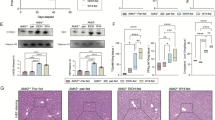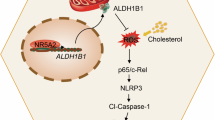Abstract
Different samples of reduced diphosphopyridine nucleotide (β-DPNH, Sigma Chemical Co.) have been found to give significantly different maximum rates of reduction of aldehyde catalysed by liver alcohol dehydrogenase. The crystalline enzyme was prepared from horse liver1 and measurements of initial rates were made with a recording fluorimeter1,2 at 23.5°. In Table 1 relative values of initial rates with 1.3 × 10−3 M acetaldehyde and 2 × 10−5 M DPNH in pH 6 phosphate buffer (ionic strength 0.1) are collated with assays of the samples of DPNH. The percentage by weight of anhydrous disodium salt was calculated from direct extinction measurements at 340 mµ (column 2), and also from the decrease of absorption of light at this wave-length (ΔE340) accompanying complete oxidation of the coenzyme by excess acetaldehyde and liver alcohol dehydrogenase (column 3), using in each case the value 6.22 (ref. 3) for the millimolar extinction coefficient. The second value is taken to be the true DPNH content. The difference between the two values is due to the presence of a substance which closely resembles DPNH in both light absorption and fluorescence emission, but is not coenzymically active with liver (or yeast) alcohol dehydrogenase. The results indicate that the samples which give the higher initial rates have the greater coenzyme content and a smaller excess of total adenine over coenzyme (column 4). Ribose and total phosphate analyses were also made ; calculating the total adenine content from the extinction at 260 mµ (pH 7) and a millimolar extinction of 15 (ref. 4), the molar ratios of ribose and phosphate to adenine were 2.1 ± 0.1 for all the samples.
This is a preview of subscription content, access via your institution
Access options
Subscribe to this journal
Receive 51 print issues and online access
$199.00 per year
only $3.90 per issue
Buy this article
- Purchase on SpringerLink
- Instant access to full article PDF
Prices may be subject to local taxes which are calculated during checkout
Similar content being viewed by others

References
Dalziel, K., Biochem. J., 80, 440 (1961).
Theorell, H., and Nygaard, A. P., Acta Chem. Scand., 8, 877 (1954).
Horecker, B. L., and Kornberg, A., J. Biol. Chem., 175, 385 (1948).
Burton, K., in Data for Biochemical Research, edit. by Dawson, R. M. C., Elliott, D. C., Elliott, W. H., and Jones, K. M., 74 (Oxf. Univ. Press, 1959).
Kornberg, A., and Pricer, W. E., J. Biol. Chem., 182, 763 (1950).
Chaykin, S., Meinhart, J. O., and Krebs, E. G., J. Biol. Chem., 220, 811 (1956). Kaplan, N. O., Colowick, S. P., and Barnes, C., ibid., 191, 461 (1951).
Kaplan, N. O., Colowick, S. P., and Nason, A., J. Biol. Chem., 191, 473 (1951).
Theorell, H., Nygaard, A. P., and Bonnichsen, R., Acta Chem. Scand., 9, 1148 (1955).
Theorell, H., Adv. Enzymology, 20, 31 (1958).
Alberty, R. A., J. Amer. Chem. Soc., 75, 1928 (1953).
Dalziel, K., Acta Chem. Scand., 11, 1706 (1957).
Author information
Authors and Affiliations
Rights and permissions
About this article
Cite this article
DALZIEL, K. An Inhibitor of Liver Alcohol Dehydrogenase in Preparations of Reduced Diphosphopyridine Nucleotide. Nature 191, 1098–1099 (1961). https://doi.org/10.1038/1911098a0
Issue date:
DOI: https://doi.org/10.1038/1911098a0
This article is cited by
-
On the mode of formation of 1,6-dihydro-NAD in NADH preparations
Carlsberg Research Communications (1979)
-
Oxidations and Transhydrogenations Involving Pyridine-Dinucleotides Catalysed by Bovine Milk Xanthine Oxidase
Nature (1963)
-
Possible Magnitude of Inhibition of Coenzyme-Substrate Reactions by Competitive Inhibitors in Coenzyme Preparations
Nature (1962)


